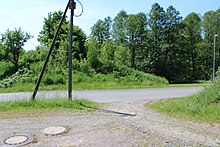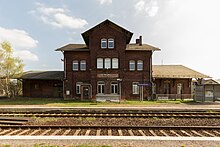Railway line Niederpöllnitz – Münchenbernsdorf
| Niederpöllnitz – Münchenbernsdorf | |||||||||||||||||||||||||||||||||
|---|---|---|---|---|---|---|---|---|---|---|---|---|---|---|---|---|---|---|---|---|---|---|---|---|---|---|---|---|---|---|---|---|---|
| Route number : | 6682 | ||||||||||||||||||||||||||||||||
| Course book range : | 200 m (1909) 169 g (1935) 187e (1944, 1967) |
||||||||||||||||||||||||||||||||
| Route length: | 8.68 km | ||||||||||||||||||||||||||||||||
| Gauge : | 1435 mm ( standard gauge ) | ||||||||||||||||||||||||||||||||
| Maximum slope : | 15.9 ‰ | ||||||||||||||||||||||||||||||||
| Minimum radius : | 300 m | ||||||||||||||||||||||||||||||||
|
|||||||||||||||||||||||||||||||||
The Niederpöllnitz – Münchenbernsdorf line was a single-track, non-electrified branch line in Thuringia . The 8.68 km long branch line was opened in 1909 and led by Niederpöllnitz at the Leipzig-Probstzella railway to Münchenbernsdorf .
Originally built for the Münchenbernsdorf carpet industry, traffic has always remained modest. From 1938 onwards, the railway only gained a certain importance through a “ Wifo ” tank farm with a connecting railway . After the cessation of passenger traffic in 1967, the railway was practically only operated for this military object at Lederhose and another tank farm built in the 1970s near Großebersdorf. In 1993, after the cessation of goods traffic, only the tank farm near Großebersdorf was served.
history
Prehistory and construction
For the first time in 1870 plans for a railway construction were made. The municipality of Münchenbernsdorf, which is characterized by the textile industry, was supposed to be the crossing point between the Gera - Roda - Weimar and (Plauen) - Mehltheuer - Aubitz railway lines , but these plans were not implemented.
From 1885 a rail connection from the northeast was considered. Different variants considered with Gera or Töppeln as a starting point ultimately favored the Gera – Münchenbernsdorf variant, because significant traffic flows were taken into account. The Niederpöllnitz – Münchenbernsdorf route, also planned by Prussia , was rejected from the start. In the years that followed until after 1900 nothing happened, everyone involved argued about the route and financing. In the meantime, further plans such as a Triptis / Pöllnitz – Münchenbernsdorf – Roda line have been drawn up. Since a direct bus line from Münchenbernsdorf to Gera was set up in 1906 and carpet manufacturers also closed their facilities in Münchenbernsdorf - which should make up the majority of the expected traffic - it seemed as if the city would no longer have a rail connection. The construction of the Gera – Münchenbernsdorf railway failed again and again due to differences between the Reuss younger line and Saxony-Weimar-Eisenach over whose territory the line was supposed to lead. As early as 1905, the Royal Railway Directorate in Erfurt had confirmed the profitability of the Niederpöllnitz – Münchenbernsdorf line. In 1907, this positive result motivated the state parliament in Weimar to prefer the Niederpöllnitz Gera starting point, which had previously been rejected for years, as the route no longer ran across Reussian territory.
The Prussian State Railway was to take over construction and management . The actual construction work for the Niederpöllnitz – Münchenbernsdorf railway began at the end of 1908; operations were scheduled to open in autumn 1909. In the summer of 1909 the first tracks were laid on the route, but the completion of the route was delayed until the beginning of November of the same year.
Until the end of World War II
The railway line was opened on November 14, 1909, the actual railway operations started one day later. The initially planned extension to Roda or Hermsdorf did not get beyond the planning stage until the outbreak of the First World War . After the end of the war, further construction was out of the question, and attempts made in this direction again at the beginning of the 1930s were just as unsuccessful.
Overall, traffic developed positively, the forecast operating results were exceeded by far, which was mainly due to freight traffic, because passenger traffic has always remained modest.
From 1935 onwards there was an increase in traffic when large parts of the building materials required for the construction of the RAB 9, which passed close to the route, were delivered over the railway line, and the components for the Tautendorf viaduct were also unloaded at Lederhose.
At the end of the Second World War , in April 1945, the tank farm was bombed. Several tank cars parked in Lederhose and Großebersdorf were shot at.
GDR time
The already started route dismantling as a reparation payment was canceled, probably because of the military importance of the "Wifo" connection taken over by the Red Army.
The low passenger traffic - the main traffic destination Gera was always much faster to reach by bus - led to poorly used trains. Therefore, on May 28, 1967, passenger traffic was stopped, which was last already operated as a replacement rail service.
The remaining freight traffic was limited to serving the former "Wifo" connection, a fuel dealer in lederhosen and coal deliveries for the Munich-Bernsdorf carpet industry.
Development since 1990
After the economic changes in 1989/90, the remaining freight traffic collapsed almost completely. After the withdrawal of the CIS army in 1992/93, practically no transport volume remained except for the operation of the Großebersdorfer tank farm. The freight traffic was then stopped on December 31, 1993. The stretch to the tank farm near Großebersdorf was completely renovated in 1994/95, the one to Münchenbernsdorf train station was shut down on June 27, 1995.
In September 2008, the tracks between the connection between the Lederhose tank farm and Münchenbernsdorf were dismantled.
Route description
course
The Niederpöllnitz station is left to the northeast, the line initially descends slightly. After changing to the north-west, the lowest point at 318 m is passed, after which the route rises again. Shortly before the former Großebersdorf train station, the B 2 is crossed at the same level ( ⊙ ), the level crossing has been secured with a barrier since 1994/95. Behind Lederhose, the highest point of the route with 366 m is reached and there is another change of direction, the route then descends again towards the northeast to the Münchenbernsdorf train station.
Operating points
- Niederpöllnitz train station ⊙
The Niederpöllnitz station , together with the section Gera Eichicht the 1871 Leipzig-Probstzella railway opened. With the construction of the branch line to Münchenbernsdorf, the station was expanded accordingly. Further renovations took place in the 1970s.
- Großebersdorf train station ⊙
The track systems of the Großebersdorf train station initially consisted of the continuous main track and a loading track with loading ramp, loading lane and the reception building with attached goods shed. The station building - which is largely identical to that of the Lederhose station - has been used for other purposes since the late 1960s, and the loading platform was probably dismantled in the 1980s.
- Connection "Material warehouse / TABEG" ⊙
The tank farm was built in the 1970s as "Tanklager 912" and was part of the strategic state reserve. The connecting line built for this purpose has a track length of about 7 km, the works traffic is handled by two 220 hp shunting locomotives, which are identical to the DR series 102 .
Initially only rarely used, the system was taken over by Tanklagerbetriebsgesellschaft mbH (TABEG) in 1989/90. A part of the stocks today also belongs to the state reserve of the FRG.
- Lederhose train station ⊙
The Lederhose station initially largely corresponded to the Großebersdorf station. The two-story entrance building has a tiled hipped roof and an attached goods shed. Together with the construction of the tank farm, the station was expanded by two tracks. When tank cars parked in the station were fired at at the end of the Second World War, the station's buildings were damaged. After 1945 the two tracks were dismantled.
- Connection "Wifo"
The Wifo built in 1938 in the woods near Münchenbernsdorf under the code name "Sundew" an underground storage tank. The tank farm, which was damaged in an air raid in April 1945, continued to be used by the Red Army after the end of World War II . The military object was only given up with the withdrawal of the CIS troops in 1992/93.
- Münchenbernsdorf train station ⊙
The Münchenbernsdorf station was always the operating center of the branch line. The goods shed is attached to the multi-storey reception building with a hipped roof. This was mainly used for shipping carpets and had to be expanded several times. There was also a two-tier engine shed and a water tower on the high-rise buildings. The engine shed was now used as a workshop, after 1990 the building and the water tower were demolished.
A small locomotive for shunting tasks had been stationed in the station since at least the end of the 1950s , and the vehicle was only withdrawn after freight traffic had ceased.
Locomotive use
Initially, the trains were carried with locomotives of the G 3 , G 5 and T 3 series . The 93.5-12 series and 58 series were then used until the early 1970s . The 65.10 and 83.10 series also ran in the first half of the 1970s . The 38 , 41 and 58.30 series were also used on the route.
The steam locomotives were replaced by the 106 series in the mid -1970s , which were supplemented by the 114 and 119 series in the mid-1980s .
The block trains were hauled by the 118 , 120 or 131 series. After 1990 the 232 series was also used for this. In the meantime, NoHAB AA16 and Vossloh G 1700-2 BB are also in service with the tank farm.
literature
- Hans-Jürgen Barteld, Hans-Bernhard Karl: The branch line Niederpöllnitz – Münchenbernsdorf. ( Secondary line documentation volume 56), Verlag Kenning, Nordhorn 1999, ISBN 3-933613-10-8
Web links
Footnotes
- ↑ 1904 declared a city
- ↑ Hans-Jürgen Barteld, Hans-Bernhard Karl: The branch line Niederpöllnitz – Münchenbernsdorf , p. 34
- ↑ Hans-Jürgen Barteld, Bernhard Karl-Hans: The branch line Niederpöllnitz-Münchenbernsdorf , p.54 f.
- ↑ Information from the Federal Railway Authority ( Memento from April 12, 2016 in the Internet Archive )
- ↑ Hans-Jürgen Barteld, Hans-Bernhard Karl: The branch line Niederpöllnitz-Münchenbernsdorf , p. 52 ff.
- ^ Franz Rittig, Hans-Jürgen Barteld: Lederhose Recommended , p. 54; in ModellEisenBahner-Spezial - From Thuringia to the Harz Mountains , 1996/97, ISSN 0026-7422
- ↑ Recording at www.oberlausitzer-eisenbahnen.de
- ↑ Recording at www.bw-vacha.de




